The Golden Box of Ngoa Van – Yen Tu, also known as the Lotus-shaped Golden Box, is a pinnacle of artistic achievement during the Tran dynasty.
Treasures Beneath the Earth
The golden box was discovered unexpectedly during the construction of the “spiritual pilgrimage” road from Trai Loc village to the Ngoa Van Pagoda relic (Dong Trieu Town, Quang Ninh Province).
Venerable Thich Quang Hien discovered a golden box that was unearthed by an excavator on the hillside. On March 20, 2015, the Dong Trieu District People’s Committee handed over the Golden Box of Ngoa Van – Yen Tu to the Quang Ninh Provincial Museum for preservation, storage, and enhancement of the artifact’s value.
Due to its rarity and uniqueness, the Golden Box of Ngoa Van – Yen Tu was recognized as a national treasure by the Prime Minister at the end of 2018.
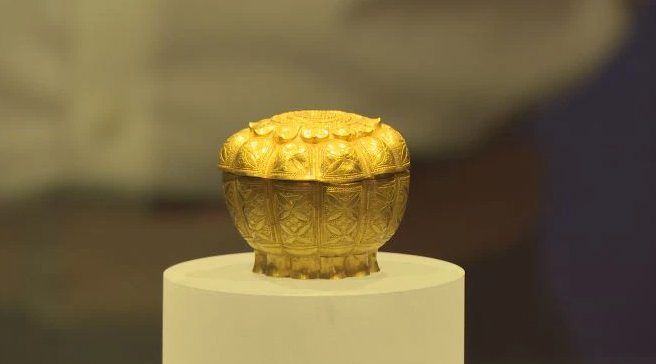
The Golden Box of Ngoa Van – Yen Tu was found during road construction. (Photo: QN).
Distinctive Cultural Features of the Tran Dynasty
The box weighs 56.44 grams (equivalent to about 15 “chi” of gold), with an overall height of 4.2 cm (including a body height of 3.2 cm with lid; base height of 0.6 cm); the lower part of the body has an inner mouth diameter of 4.8 cm, an outer mouth diameter of 5.1 cm, a base diameter of 3.5 cm, and a lid diameter of 5.1 cm.
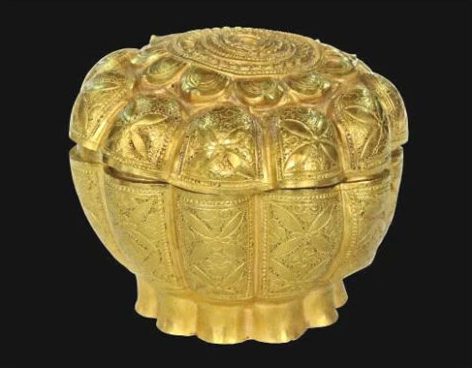
The Golden Box of Ngoa Van – Yen Tu is made entirely of gold, weighing 56.44g. (Source: Quang Ninh Museum)
The box has a spherical shape, with 11 lobes on the body, each lobe resembling a curved lotus petal. During excavation, the excavator’s bucket struck the body of the box, causing slight deformation. The lid is hemispherical, with 11 main lobes corresponding to the body, forming a large outer layer of petals; in the center of the lid is a lotus pedestal surrounded by large petals. The patterns are intricately hand-carved.
The decorative motifs, with a cloud-patterned background, showcase the craftsmanship and technical skill of contemporary artisans. The fine lines and small motifs exhibit sharp, robust carvings on a very thin base.
Dr. Bui Minh Tri, Director of the Imperial City Research Center, Vietnam Academy of Social Sciences, was invited to authenticate the box. He stated that the box was made using a technique that combines mold casting to form the shape and raised lotus petals, followed by carving the patterns on the body and inside the petals. All decorative motifs on the lid and body of the box strongly reflect the cultural characteristics of the Tran dynasty in the first half of the 14th century.
Researchers believe that the Golden Box of Ngoa Van – Yen Tu is an important artifact related to royalty or sacred religious rituals. It is a bowl, known as “At Gia,” one of the six essential ritual objects used in Vajrayana Buddhist ceremonies, and this artifact may be connected to the Ngoc Van relic or the Moc Cao relic.
Significant Value
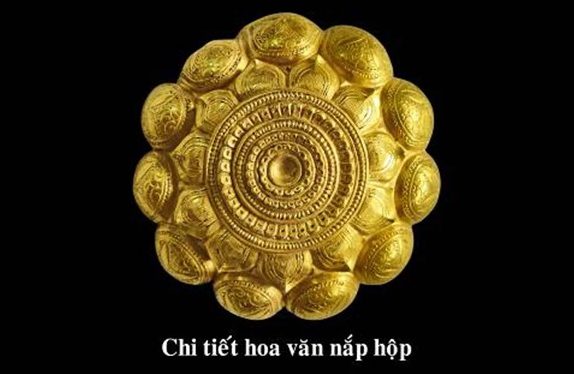
The patterns on the golden box exemplify the artistic style of the Tran dynasty. (Source: Quang Ninh Museum)
The Golden Box of Ngoa Van – Yen Tu is a remarkable work of art, resembling a lotus flower in full bloom. The patterns on the golden box are hand-carved, with the interiors of the lotus petals decorated with lemon flower motifs, showcasing the exceptional skill and craftsmanship of contemporary artisans.
In terms of material, according to results from the Antiquities Evaluation Council of the Ministry of Culture, Sports and Tourism conducted on October 9, 2012, the box is composed of 90% gold, with the remainder being other metals to enhance its hardness.
It can be said that the Golden Box of Ngoa Van – Yen Tu has reached the pinnacle of craftsmanship and art during the Tran dynasty. Based on its material and exquisite quality, the Golden Box of Ngoa Van may be a precious item belonging to the royal family, possibly used in sacred rituals related to Buddhism.
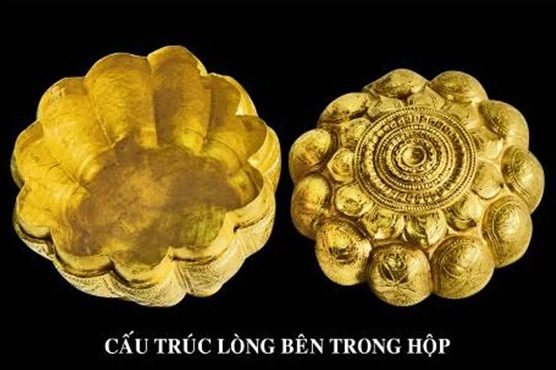
The intricate patterns of this Tran dynasty treasure. (Source: Quang Ninh Museum)
The location of the box’s discovery is next to the Moc Cao hermitage, which is the hermitage of Queen Mother Thuan Thanh Bao Tu (1), the eldest daughter of Prince Hung Nhuong Tran Quoc Tang, son of General Hung Dao Tran Quoc Tuan, so it is very likely connected to her life.
Mr. Kieu Dinh Son, Director of the Quang Ninh Museum, stated: The Golden Box of Ngoa Van – Yen Tu was chosen as a national treasure because it embodies many unique and distinct values; first, it is an original artifact, unique, and remains intact, with no individual or locality in Vietnam having discovered or preserved a similar artifact; second, the artifacts have unique shapes, exquisite decorative patterns, and a cohesive layout; third, it holds significant scientific and historical value.
This is the only surviving gold artifact from the Tran dynasty, featuring a unique shape, exquisite decorative patterns, and a cohesive layout, reflecting the high level of goldsmithing skills, aesthetic standards, and creative intellect of artisans from the Tran dynasty.
According to research, the Golden Box of Ngoa Van – Yen Tu is a ritual object known as “At Gia Qi” (2), a term used to refer to a bowl or cup containing fragrant water in Buddhist offerings.
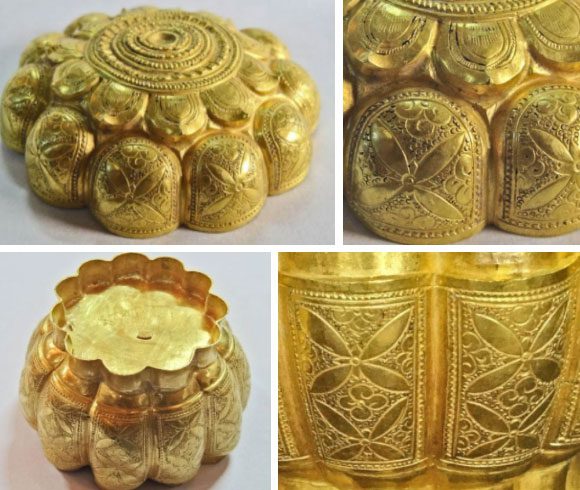
Close-up of the Golden Box of Ngoa Van – Yen Tu. (Photo: Imperial City Research Center).
The discovery of the Golden Box of Ngoa Van on the pilgrimage path to the Ngoa Van hermitage contributes important material to affirm the value of the Ngoa Van relic, the sacred site of the Truc Lam Zen sect, while also reflecting the thoughts and cultural life of the spiritual elite in the Truc Lam Buddhist center.
Moreover, the Golden Box of Ngoa Van also reflects the high level of goldsmithing skills, aesthetic standards, and creative intellect of artisans from the Tran dynasty, contributing to affirming the artistic value of the Tran dynasty from the perspective of rare gold and silver craftsmanship, which has been very rarely seen under the Dinh – Early Le, Ly, Tran, Early Le, Mac, and Later Le dynasties.
|
(1) Queen Mother Bao Tu Thuan Thanh (? – July 1330), was the queen of Tran Anh Tong and the biological mother of Tran Minh Tong. She was the youngest daughter of General Hung Nhuong Dai Vuong Tran Quoc Tang, with her mother being Bao An Quoc Mau. She referred to General Hung Dao Tran Quoc Tuan as her grandfather and King Kham Minh Tran Lieu as her great-grandfather, hailing from the Tran royal family. She was known for her devout Buddhism. (2) At Gia Qi is one of the six ritual objects (Fire Offering, At Gia Qi, Incense Offering, Flower Offering, Dang Minh Qi, Warm Food Qi), referring to a vessel containing At Gia, fragrant powder, and flowers for offerings. |




















































